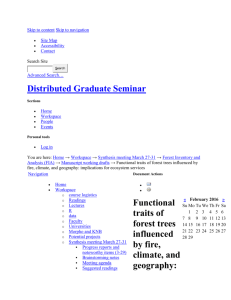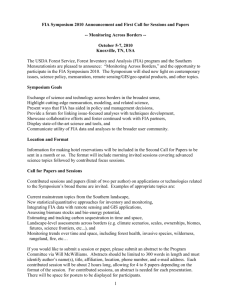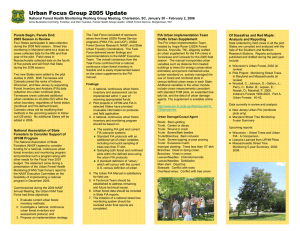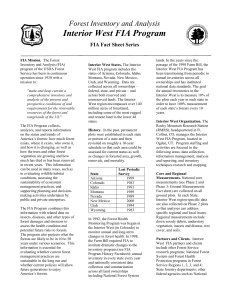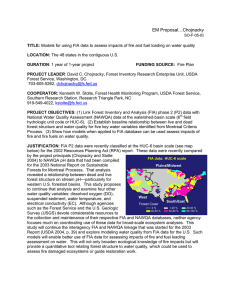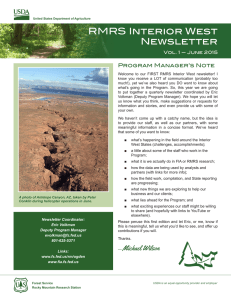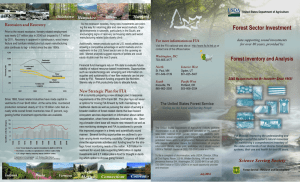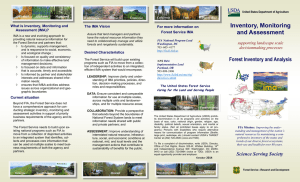Forest Service Research & Development (FS R&D)
advertisement
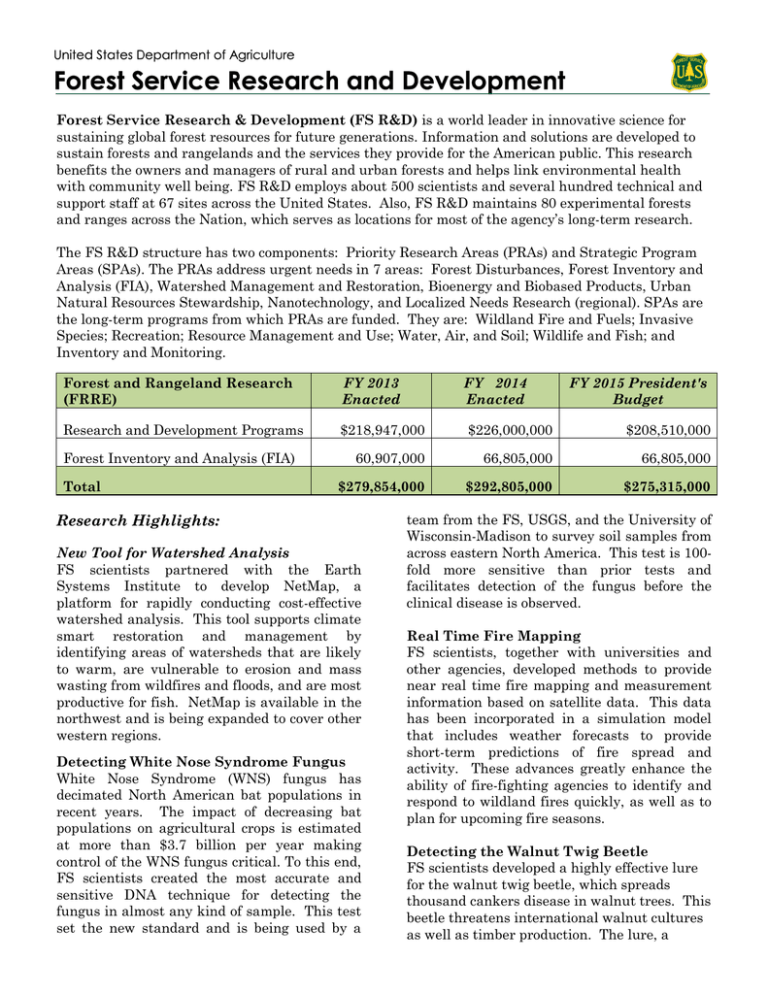
Forest Service Research & Development (FS R&D) is a world leader in innovative science for sustaining global forest resources for future generations. Information and solutions are developed to sustain forests and rangelands and the services they provide for the American public. This research benefits the owners and managers of rural and urban forests and helps link environmental health with community well being. FS R&D employs about 500 scientists and several hundred technical and support staff at 67 sites across the United States. Also, FS R&D maintains 80 experimental forests and ranges across the Nation, which serves as locations for most of the agency’s long-term research. The FS R&D structure has two components: Priority Research Areas (PRAs) and Strategic Program Areas (SPAs). The PRAs address urgent needs in 7 areas: Forest Disturbances, Forest Inventory and Analysis (FIA), Watershed Management and Restoration, Bioenergy and Biobased Products, Urban Natural Resources Stewardship, Nanotechnology, and Localized Needs Research (regional). SPAs are the long-term programs from which PRAs are funded. They are: Wildland Fire and Fuels; Invasive Species; Recreation; Resource Management and Use; Water, Air, and Soil; Wildlife and Fish; and Inventory and Monitoring. Forest and Rangeland Research (FRRE) FY 2013 Enacted Research and Development Programs $218,947,000 $226,000,000 $208,510,000 60,907,000 66,805,000 66,805,000 $279,854,000 $292,805,000 $275,315,000 Forest Inventory and Analysis (FIA) Total Research Highlights: New Tool for Watershed Analysis FS scientists partnered with the Earth Systems Institute to develop NetMap, a platform for rapidly conducting cost-effective watershed analysis. This tool supports climate smart restoration and management by identifying areas of watersheds that are likely to warm, are vulnerable to erosion and mass wasting from wildfires and floods, and are most productive for fish. NetMap is available in the northwest and is being expanded to cover other western regions. Detecting White Nose Syndrome Fungus White Nose Syndrome (WNS) fungus has decimated North American bat populations in recent years. The impact of decreasing bat populations on agricultural crops is estimated at more than $3.7 billion per year making control of the WNS fungus critical. To this end, FS scientists created the most accurate and sensitive DNA technique for detecting the fungus in almost any kind of sample. This test set the new standard and is being used by a FY 2014 Enacted FY 2015 President's Budget team from the FS, USGS, and the University of Wisconsin-Madison to survey soil samples from across eastern North America. This test is 100fold more sensitive than prior tests and facilitates detection of the fungus before the clinical disease is observed. Real Time Fire Mapping FS scientists, together with universities and other agencies, developed methods to provide near real time fire mapping and measurement information based on satellite data. This data has been incorporated in a simulation model that includes weather forecasts to provide short-term predictions of fire spread and activity. These advances greatly enhance the ability of fire-fighting agencies to identify and respond to wildland fires quickly, as well as to plan for upcoming fire seasons. Detecting the Walnut Twig Beetle FS scientists developed a highly effective lure for the walnut twig beetle, which spreads thousand cankers disease in walnut trees. This beetle threatens international walnut cultures as well as timber production. The lure, a synthetic beetle pheromone, enables faster detection and mapping of this invasive insect. strategies that improve environmental health and community well-being into the future. Cellulose Nanocrystal Pilot Plant In August 2012, the Forest Products Lab unveiled a production facility for renewable, forest-based nanomaterials. This facility is the first of its kind in the U.S. and supports an emerging market for wood-derived renewable nano-materials, helping spur forest-based job growth and contributing an estimated $42 billion to the American economy by 2020. Accessible FIA Data FS R&D implemented FIA annual forest sampling in all 50 states. Over 42,000 field plots were measured representing 14 percent of the FIA national plot system. FIA data less than 2 years old is accessible at www.fia.fs.fed.us. Urban Tree Analysis FS scientists analyzed urban tree cover nationally revealing a decline of about 20,000 acres or about four million trees per year. Understanding changes and trends in urban forests helps cities and towns develop urban forest management plans and sustainability National Green Building Standard FS R&D cooperated with the National Association of Home Builders to develop the National Green Building Standard. The standard promotes the use of green building materials and provides incentives for architects and builders to specify and use non-residential wood in green construction. FY 2015 President’s Budget The FY 2015 President’s Budget proposes $275,315,000 for Forest and Rangeland Research, a decrease of $17,490,000 from the FY 2014 Enacted level. The request provides $66,805,000 for the Forest Inventory and Analysis (FIA) program. resource stewardship, nanotechnology, and Funding focuses on key research associated restoration and climate adaptation research. with the Priority Research Areas and Strategic Program Areas. Research supporting watershed restoration, soil conservation during road decommissioning, This funding level maintains capacity to and air quality research in support of forest address priority invasives research, including health management will continue. the introduction and spread of non-native species, by eliminating some research on Funding supports implementation of the FIA established indigenous species. program in all States, except interior Alaska. The re-measurement cycle will be extended to Wildland Fire and fuels research will focus on 10 years. Our ability to leverage funding with research on fire regimes, fire impacts on partners will continue at a lower level. forested ecosystems, improving the Other Budget Line Items: understanding and tools related to fire emissions, smoke management, and real-time reporting. National Fire Plan funds research at $19,795,000, consistent with the FY 2014 level. Priority recreation science will continue in support of resilient ecosystems and thriving Joint Fire Science Program funds research communities. at $6,914,000, consistent the FY 2014 level. Funding will focus on high priority research such as integrated management and production systems, sustainable bioenergy production, urban sustainability, and natural Capital Improvement and Maintenance provides approximately $5 million for facility related projects.
